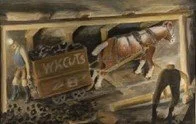The Pitmen Painters at Woodhorn Museum
This year, 2024, is the 40th anniversary of the miners’ strike and there has already been a great deal of coverage in the media as well as at our local mining museum, Woodhorn, which has provoked much thought about that tumultuous year and its often shocking events.
But Woodhorn is also commemorating another, perhaps less dramatic anniversary connected to the miners who worked locally in the Ashington area. In 1934 a group of them started gathering weekly in a hut near the Ashington pit, to learn about modern art and to try their hand at some of the techniques that the tutor introduced to them. They had previously met as a workers’ educational association group studying evolution, and so had already enjoyed the opportunity to inject something different from the ‘day job’ into their lives. This group together with others who joined later continued to meet and paint and share opinions about what they were doing and how they approached their work right through until the 1980s. The result of that output, now under the care of the trustees of The Ashington Group, can be seen at Woodhorn in two collections.
There is a permanent exhibition in one gallery; these works can also be seen online at https://museumsnorthumberland.org.uk/our-collections/the-ashington-group/virtual-gallery/
Until October of this year there is an additional show in another gallery within The Cutter, the main museum building. This second group of paintings are all by a single member of the Pitmen Painters / Ashington Group artists, Oliver Kilbourn.
He painted the collection of 39 works, all acrylic on watercolour paper, during the 1970s after retirement. Kilbourn worked his entire career as a miner, mostly at Ellington colliery. The collection on temporary display in the West Gallery illustrates this working life, starting the week after he became 13. It moves from becoming the following year a pom pom boy (raking out the unusable small pieces of coal cut by a compressed air machine) to his last years as a salvage drawer and then a wasteman, (both important jobs involving making safe the parts of the mine that had been exhausted). The paintings show the different jobs he performed during that time, putting, filling (both involving managing tubs of coal) drilling and shot-firing (preparing a new coal face) as well as some of the lighter moments underground. Now, long after the pit closures and the loss of the many crafts involved, we see some of the common practices of work underground. Kilbourn commented later, looking back: “Art has been my main interest in life since then.”
Philip Hood
Pictured: 'Geton! How-way!! SANDY!!! Pulling out the full tub' by Oliver Kilbourn
Events during this anniversary year can be seen at https://museumsnorthumberland.org.uk/whats-on/?type=ashington-group-90

